Aging deadwood with winter in a can
+15
Bob Pressler
plant_dr
Mitch Thomas
Poink88
Loke Emil
stagz
Patrick_G
JudyB
fiona
JimLewis
Fore
JMcCoy
Khaimraj Seepersad
yamasuri
marcus watts
19 posters
Page 1 of 2
Page 1 of 2 • 1, 2 
 Aging deadwood with winter in a can
Aging deadwood with winter in a can
When I look at artificially created deadwood 99% of the time it looks very poor compared to naturally aged sections of the tree. I dont mean the initial carving to add a basic shape to the wood but the finishing as this stage needs to show the effect of weathering where the manual methods used seem to remove it. Even sandblasting goes against convincing aging as the method removes the surface layer that has the cracks forming, although blasting is a good initial stage to make definition between the hard and soft wood. The good deadwood workers know they have only completed the first stage, but it is easy to see their work in pictures and think this is the finished goal to aim for.
Nature makes a maze of cracks, splits and grooves that vary in width and depth while following the grain perfectly, while power tools often make uniform grooves that follow the hand of the operator ! A scalpel is good for making a few slices in the wood surface but if overused looks just as false and uniform as power tools. Over the years I've noticed how the weather conditions directly effect the appearance of the deadwood - in wet weather the wood is swollen, the large cracks are smaller and the fine cracks have often disappeareed completely and when the wood dries in the sun it shrinks back, opening the cracks up again. After a good cold winter I've noticed how much better the wood has aged and I think this comes from wet wood freezing so the ice opens the existing cracks up and also makes new ones. With this in mind I have been developing a brand new tecnique to put the deadwood through as many freezing winter days as possible, in a much shorter time scale.
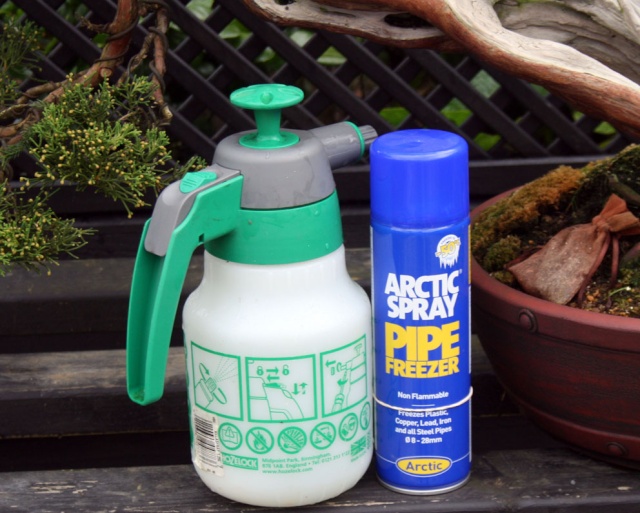
This little can directs an icy blast of -50 degrees onto the deadwood - freezing it absolutely solid in moments. This is a brand new bonsai method to the best of my knowledge - so here is an ibc exclusive
(If you are working with new wood add a few score lines with a scalpel, working with the grain.)
First off the wood needs to be saturated, so spray it well or better still start the work after a few days of rain. - Give the wood one more fine spray so the existing cracks are full of water, then shield or protect the foliage before directing the spray onto the area being worked on.

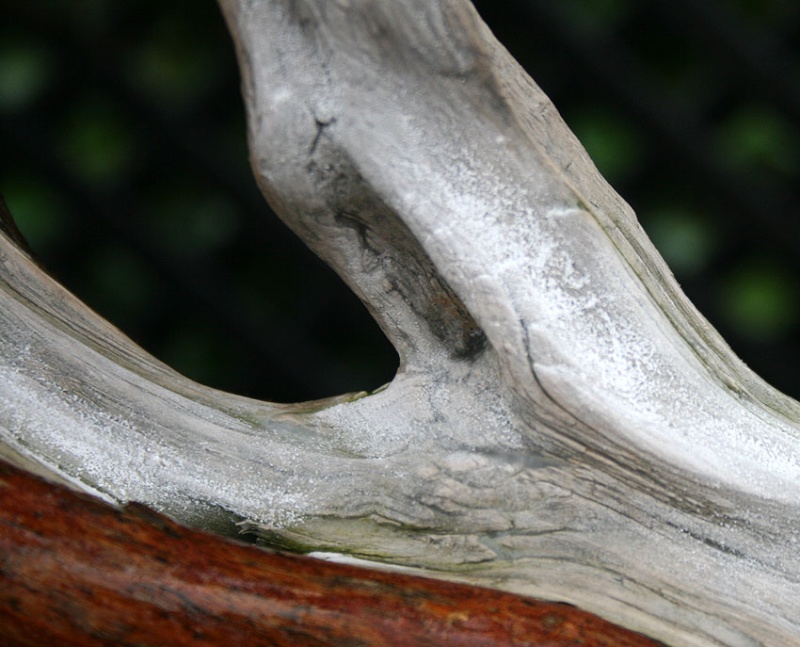
After treating for a minute at most, working is short bursts, the jin is frozen solid and the cracks are visibly full of ice. I then spray the jin with water again to thaw it out and repeat the work four or five times over an afterrnoon working on the trees.
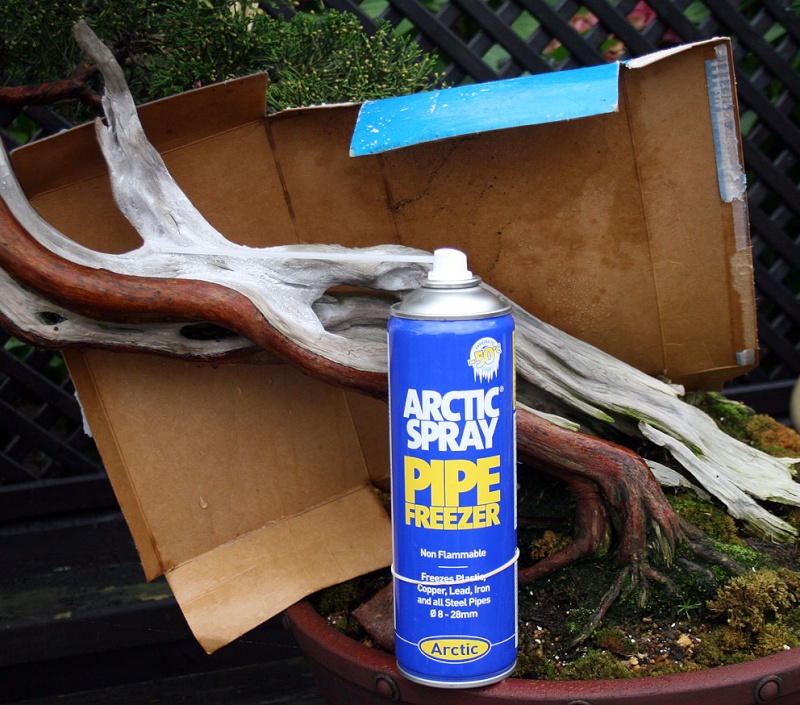
After one final freezing of the working area I let the wood thaw naturally. You can speed the cracking up at this stage if you use a hair dryer to dry and quickly shrink the wood, or you can just let it dry in the sun.
These two pictures are genuinely taken one hour apart - top one before treating and lower one after 5 freeze treatments - This is probably more weathering than an entire Cornish winter on one September afternoon


Even the colour has improved - I think this visibly proves you can help nature and weathering along a bit. Dont freeze foliage or live veins though!
While you are doing work like this do not use modern wood sealers or preservatives as we are aging the wood and they are anti aging products. Avoid oils as well as they repel water and we need the water in the wood to expand when it freezes.
cheers,
Marcus
Nature makes a maze of cracks, splits and grooves that vary in width and depth while following the grain perfectly, while power tools often make uniform grooves that follow the hand of the operator ! A scalpel is good for making a few slices in the wood surface but if overused looks just as false and uniform as power tools. Over the years I've noticed how the weather conditions directly effect the appearance of the deadwood - in wet weather the wood is swollen, the large cracks are smaller and the fine cracks have often disappeareed completely and when the wood dries in the sun it shrinks back, opening the cracks up again. After a good cold winter I've noticed how much better the wood has aged and I think this comes from wet wood freezing so the ice opens the existing cracks up and also makes new ones. With this in mind I have been developing a brand new tecnique to put the deadwood through as many freezing winter days as possible, in a much shorter time scale.

This little can directs an icy blast of -50 degrees onto the deadwood - freezing it absolutely solid in moments. This is a brand new bonsai method to the best of my knowledge - so here is an ibc exclusive
(If you are working with new wood add a few score lines with a scalpel, working with the grain.)
First off the wood needs to be saturated, so spray it well or better still start the work after a few days of rain. - Give the wood one more fine spray so the existing cracks are full of water, then shield or protect the foliage before directing the spray onto the area being worked on.


After treating for a minute at most, working is short bursts, the jin is frozen solid and the cracks are visibly full of ice. I then spray the jin with water again to thaw it out and repeat the work four or five times over an afterrnoon working on the trees.

After one final freezing of the working area I let the wood thaw naturally. You can speed the cracking up at this stage if you use a hair dryer to dry and quickly shrink the wood, or you can just let it dry in the sun.
These two pictures are genuinely taken one hour apart - top one before treating and lower one after 5 freeze treatments - This is probably more weathering than an entire Cornish winter on one September afternoon


Even the colour has improved - I think this visibly proves you can help nature and weathering along a bit. Dont freeze foliage or live veins though!
While you are doing work like this do not use modern wood sealers or preservatives as we are aging the wood and they are anti aging products. Avoid oils as well as they repel water and we need the water in the wood to expand when it freezes.
cheers,
Marcus

marcus watts- Member
dprm likes this post
 Re: Aging deadwood with winter in a can
Re: Aging deadwood with winter in a can
Not bad Markus. I think big/large jin/dedwood treat like you do is no problem. Small parts will be problem of possible freez the surounding bark parts or foliage. Will try. This technique is definitely progres. Thanks for sharing...hope I can find "pipe freezer" around here stores

yamasuri- Member
 Re: Aging deadwood with winter in a can
Re: Aging deadwood with winter in a can
yamasuri wrote:Not bad Markus. I think big/large jin/dedwood treat like you do is no problem. Small parts will be problem of possible freez the surounding bark parts or foliage. Will try. This technique is definitely progres. Thanks for sharing...hope I can find "pipe freezer" around here stores
Thanks,
yes, i agree totally - not for small trees - the spray can freeze a 28mm internal diameter lead pipe absolutely solid and the plug stays frozen for over half an hour so you would freeze an entire small tree or branch right through killing it for sure.

marcus watts- Member
 Re: Aging deadwood with winter in a can
Re: Aging deadwood with winter in a can
Marcus,
fascinating. Never even knew that there something called - Pipe Freezer.
What will you inventors think of next?
Later.
Khaimraj
fascinating. Never even knew that there something called - Pipe Freezer.
What will you inventors think of next?
Later.
Khaimraj

Khaimraj Seepersad- Member
 Re: Aging deadwood with winter in a can
Re: Aging deadwood with winter in a can
Like the others, I've never heard of such a thing as a "pipe freezer spray". But I certainly like the results it gives! I think there's a new tool to search out. The same caution we use with torches should probably be used with this. Great find Marcus, and great technique, thank you for sharing!
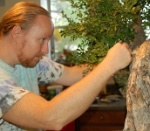
JMcCoy- Member
 Re: Aging deadwood with winter in a can
Re: Aging deadwood with winter in a can
Very Impressive Marcus! I too have never heard of that product, but will seek it out. The results are amazing! Thanks for sharing!

Fore- Member
 Re: Aging deadwood with winter in a can
Re: Aging deadwood with winter in a can
What an interesting technique! Thanks for sharing it, Marcus.

fiona- Member
 Re: Aging deadwood with winter in a can
Re: Aging deadwood with winter in a can
Wow, that's some amazing results. Do you think it would be safe to use on deciduous trees as well? You are pioneering new territory here, thanks for letting us in on the ground floor!
JudyB- Member
 Re: Aging deadwood with winter in a can
Re: Aging deadwood with winter in a can
You can get the same result from that can by turning a can of Keyboard Cleaner upside down. It sounds crazy but it works. All the canned pressurized air will do that.
Patrick_G- Member
 Re: Aging deadwood with winter in a can
Re: Aging deadwood with winter in a can
Seriously Impressed Marcus... godda give it a blast (sorry) as the results speak for themselves.
Guest- Guest
 Re: Aging deadwood with winter in a can
Re: Aging deadwood with winter in a can
P_Gravel wrote:You can get the same result from that can by turning a can of Keyboard Cleaner upside down. It sounds crazy but it works. All the canned pressurized air will do that.
nearly but not quite - normal cans are nowhere near as cold due to being less pressurised - thats why plumbers need to use proper 'pipe freeze' to make the solid plug of water inside metal pipes. This stuff comes out like a mini rocket engine
There is a jacket system too that surrounds the pipe (it could easily contain the jin). then you inject the spray and it concentrates it right where you need it. I had another play about today and best method is to wet the wood - freeze it solid - then dry it quickly with hot air, getting the wood nice and warm. It could work even better on deciduous trees - especially if the the species has softer wood - I'm sure we'll soon find out
This could be just as damaging as a blow torch though as pointed out above, so go carefull !
cheers everyone

marcus watts- Member
 Re: Aging deadwood with winter in a can
Re: Aging deadwood with winter in a can
It's not likely a technique you'd use with too many shohin or smaller tees, I suspect.

JimLewis- Member
 Re: Aging deadwood with winter in a can
Re: Aging deadwood with winter in a can
i tried a similar technique on a piece of drift wood used for a tanuki. i froze it using some left over refrigerant from work. then heated it with an oxy/acetaline torch, and repeated the process multiple times to give it a constant expansion and contraction. i wouldnt advise using refrigerant an any living material or material you want to seal right away after due to the fact that all refrigerants have different types of oil in them. youll have to clean it very well and dry it out before being able to use any wood preservers/ lime sulpher/ etc on it. but it also had an amazing result! im going to have to find some of the pipe freeze that's a great idea, or maybe even some dry ice!

stagz- Member
 Re: Aging deadwood with winter in a can
Re: Aging deadwood with winter in a can
Hm!
very interesting indeed, Marcus. Except I would like to know if there is any environmental issues involved in using the freeze can?
Come to think of it, when I was younger I used to work with CO2 guns (paint ball equipment). These guns were "fired" by frozen CO2 in portable pressure tanks, which would reach -80celsius if blown out in free air. These pressure tanks are refillable...and attached to a pressure hoze with an air brush pen, it would perhabs work as a creative tool for artistic ageing on delicate deadwood, just as well.
regards
/Loke Emil
very interesting indeed, Marcus. Except I would like to know if there is any environmental issues involved in using the freeze can?
Come to think of it, when I was younger I used to work with CO2 guns (paint ball equipment). These guns were "fired" by frozen CO2 in portable pressure tanks, which would reach -80celsius if blown out in free air. These pressure tanks are refillable...and attached to a pressure hoze with an air brush pen, it would perhabs work as a creative tool for artistic ageing on delicate deadwood, just as well.
regards
/Loke Emil
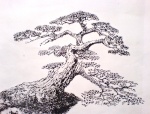
Loke Emil- Member
 Re: Aging deadwood with winter in a can
Re: Aging deadwood with winter in a can
Marcus,
Great technique. Thanks for sharing!

Great technique. Thanks for sharing!
I like your idea...definitely worth looking into.Loke Emil wrote:Hm!
very interesting indeed, Marcus. Except I would like to know if there is any environmental issues involved in using the freeze can?
Come to think of it, when I was younger I used to work with CO2 guns (paint ball equipment). These guns were "fired" by frozen CO2 in portable pressure tanks, which would reach -80celsius if blown out in free air. These pressure tanks are refillable...and attached to a pressure hoze with an air brush pen, it would perhabs work as a creative tool for artistic ageing on delicate deadwood, just as well.
regards
/Loke Emil

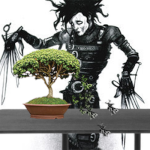
Poink88- Member
 Re: Aging deadwood with winter in a can
Re: Aging deadwood with winter in a can
Loke Emil wrote:Hm!
very interesting indeed, Marcus. Except I would like to know if there is any environmental issues involved in using the freeze can?
Come to think of it, when I was younger I used to work with CO2 guns (paint ball equipment). These guns were "fired" by frozen CO2 in portable pressure tanks, which would reach -80celsius if blown out in free air. These pressure tanks are refillable...and attached to a pressure hoze with an air brush pen, it would perhabs work as a creative tool for artistic ageing on delicate deadwood, just as well.
regards
/Loke Emil
yes - the plumbing supply depots have proper kits that work with refillable high pressure co2 cylinders - I have a co2 fire extinguisher or two in the shed too- if i can create a fine nozzle and a control valve it will be perfect - bottle will need a regulator fitting, which is easy enough, otherwise the pressure will blow a fine tube and nozzle to bits and probably freeze my fingers
if there were environmental issues the plumbers probably would not be able to use the stuff in peoples homes every day I guess - my local supply store had about 5 brands and dozens of cans of each brand on the shelf - so a very common product. No residue with this product either so no need to worry about cleaning the wood off before sealing etc. Releasing a bit of co2 is fine, nature is doing it all the time
I did find it environmentally usefull actually (to my tree) - I knew there were various bugs living in 2 of my junipers' hollow trunks.......a short blast inside the trunk and lots of solid frozen bugs blew out the other end
cheers everyone, glad you can see potential uses for my method - it does work best if you have (or make) the first splits / cracks in the wood already - the key is the water in the wood expanding rather than just dry freezing.
winter is coming

marcus watts- Member
 Re: Aging deadwood with winter in a can
Re: Aging deadwood with winter in a can
Hi Marcus
The tecknique gives very nice results.
How many years have you used it?....do you know for sure this hard freeze in september,or any other time of year, does not hurt a tree, still in growth?....like the tree on the photo?.
How about prunus,or other broadleaf trees, how will they react to this hard freeze?.
Kind regards Yvonne
The tecknique gives very nice results.
How many years have you used it?....do you know for sure this hard freeze in september,or any other time of year, does not hurt a tree, still in growth?....like the tree on the photo?.
How about prunus,or other broadleaf trees, how will they react to this hard freeze?.
Kind regards Yvonne
Guest- Guest
 Re: Aging deadwood with winter in a can
Re: Aging deadwood with winter in a can
Hey All,
This kind of product is also used in the electronics industry, so if you can't find the plumbers version, you could try electronics hobby stores or larger online retailers like RS. Just do a google image search for "electronics freeze spray" and you'll get a bunch of names. Marcus, wood is quite a good insulator as opposed to metals that conduct very well, so although I have no experience with having tried this technique, I'd guess the extent of the freezing on dead-wood, and its possible affecting living tissue near by may not be as much of a problem as you suggest. Again, no experience here so I stand to be corrected.
A very interesting technique!
Cheers,
Andrew
This kind of product is also used in the electronics industry, so if you can't find the plumbers version, you could try electronics hobby stores or larger online retailers like RS. Just do a google image search for "electronics freeze spray" and you'll get a bunch of names. Marcus, wood is quite a good insulator as opposed to metals that conduct very well, so although I have no experience with having tried this technique, I'd guess the extent of the freezing on dead-wood, and its possible affecting living tissue near by may not be as much of a problem as you suggest. Again, no experience here so I stand to be corrected.
A very interesting technique!
Cheers,
Andrew
Andrew Legg- Member
 Re: Aging deadwood with winter in a can
Re: Aging deadwood with winter in a can
Yvonne Graubaek wrote:Hi Marcus
The tecknique gives very nice results.
How many years have you used it?....do you know for sure this hard freeze in september,or any other time of year, does not hurt a tree, still in growth?....like the tree on the photo?.
How about prunus,or other broadleaf trees, how will they react to this hard freeze?.
hi Yvonne, thanks, yes it does.
i look at old bleached dead wood as just dead so wet, cold, warm or dry makes absolutely no difference to me - people carve it, burn it, chisel it and paint all sorts of stuff on it every month of the year, so soaking and freezing is just another thing to do to it - at the end of the day you have to be happy and comfortable to do all sorts of strange methods to your trees in order to achieve the desired results though - i tend to keep my thoughts clear and realistic ie dead wood cant be killed rather than worrying about 'what ifs'.
Many of my trees come from a part of the UK that has had frosts in 10 different months of the year so a freezing blast on sept 30th doesnt worry me at all.
broadleafs.......i dont actually have one that i want cracked dead wood on (just natural dark rotted hollows) so havent found the need to try it. If i had one i'd freeze it the same way though - wood is just wood once its dead. I have been purposely opening the grain with water and freezing the wood for a year or so now - this is the culmination of those experiments and now gives me the control to direct the winter weather where and when i need it.
I agree about the insulation properties of wood too Andrew, but it is better to overstate caution on a forum or someone will over do it and put their tree in the blast freezer
cheers all - anyone got golf clubs for sale

marcus watts- Member
 Re: Aging deadwood with winter in a can
Re: Aging deadwood with winter in a can
Hi Marcus
A kind of strange answer from you....Everybody knows all sorts of things is done to trees, to make the deadwood look better...I just never heard about this hard frezing and wanted to know if this was just as "safe" as all the other ways.
You have used this tecqnike for a year or so now. Thank you for this answer.
Kind regards Yvonne
A kind of strange answer from you....Everybody knows all sorts of things is done to trees, to make the deadwood look better...I just never heard about this hard frezing and wanted to know if this was just as "safe" as all the other ways.
You have used this tecqnike for a year or so now. Thank you for this answer.
Kind regards Yvonne
Guest- Guest
 Re: Aging deadwood with winter in a can
Re: Aging deadwood with winter in a can
marcus watts wrote: anyone got golf clubs for sale
Found the perfect one for you Marcus Here
You must be a rich guy!
Guest- Guest
Page 1 of 2 • 1, 2 
 Similar topics
Similar topics» Temperate winter care for olive, bay leaf and winter jasmine?
» Juniperus squamata since 2010
» What to do!
» What a carve up
» A deadwood yew
» Juniperus squamata since 2010
» What to do!
» What a carve up
» A deadwood yew
Page 1 of 2
Permissions in this forum:
You cannot reply to topics in this forum






